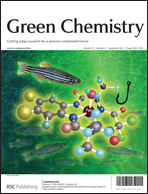In this work, a 21-carbon dicarboxylic acid (C21DA) and a 22-carbon tricarboxylic acid (C22TA) were prepared by the Diels–Alder addition of tung oil fatty acids with acrylic acid and fumaric acid, respectively, and subsequently converted to the corresponding di- and triglycidyl esters. There were no solvents used in the addition and glycidylation reactions. The excess epichlorohydrin used in the latter reaction could be recovered and reused. Furthermore, for the first time, calcium oxide was introduced as a water scavenger in the glycidylation process to effectively avoid the side reactions. The chemical structures of the products were confirmed using 1H NMR, 13C NMR and ESI-MS analyses. The curing behaviors of the di- and triglycidyl esters were studied using differential scanning calorimetry. Flexural, impact and dynamic mechanical properties of the cured resins were also determined. A commercial bisphenol A epoxy DER 332 and an epoxidized soybean oil (ESO) were used as controls in the study. Results indicated that the obtained diglycidyl and triglycidyl esters had overall superior performance to that of ESO for epoxy applications. Particularly, the triglycidyl ester of the C22TA displayed comparable strength, modulus and glass transition temperature to that of DER332.

You have access to this article
 Please wait while we load your content...
Something went wrong. Try again?
Please wait while we load your content...
Something went wrong. Try again?


 Please wait while we load your content...
Please wait while we load your content...